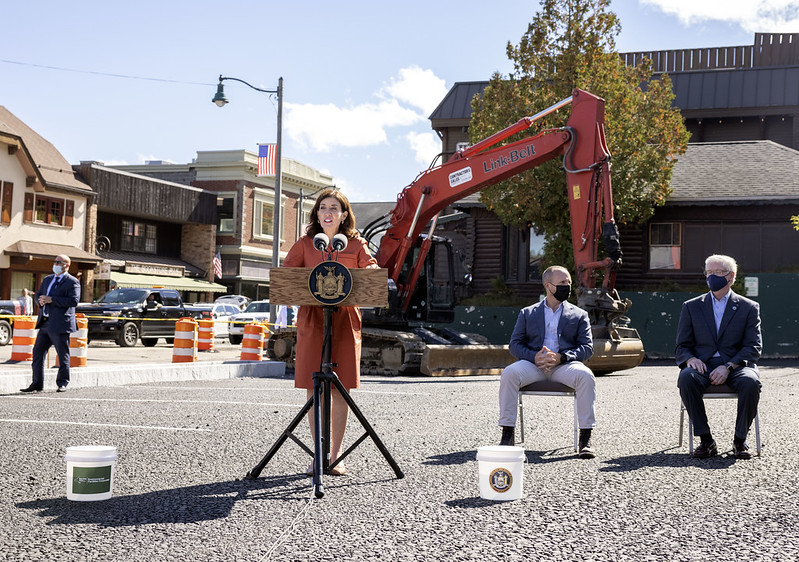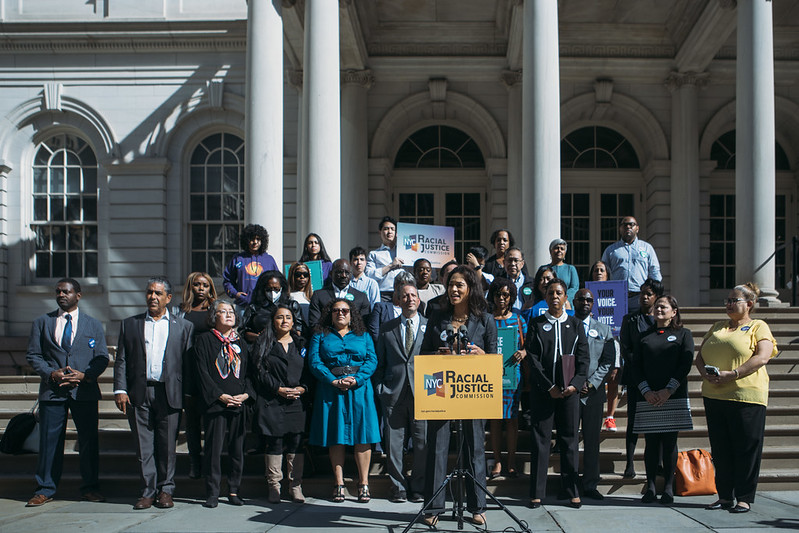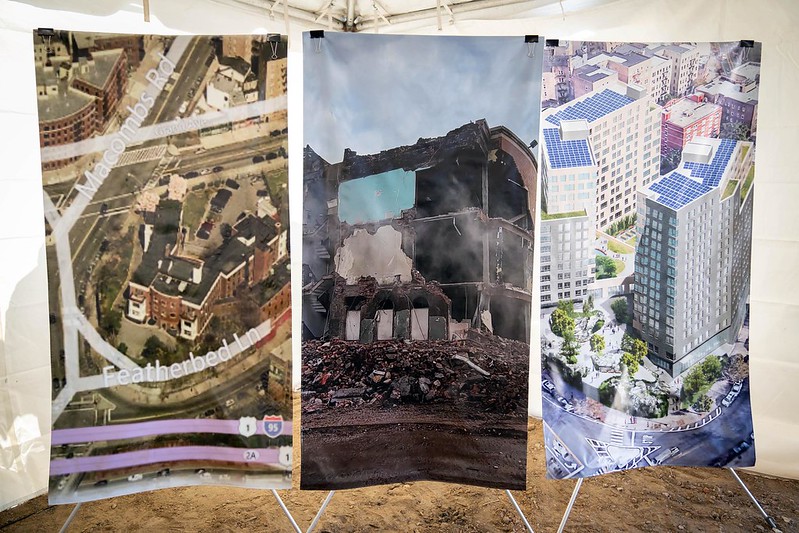 |
|
| Grand Central Depot, now known as Grand Central Station. |
The rulers of what was then New Amsterdam institute the first traffic regulations in America. The law bars wagons, carts and sleighs from being driven at a gallop.
1693 - First Bridge
The first bridge in the city, King's Bridge connects Manhattan and what is now the Bronx. It is demolished in 1917.
1811 - Ferry Service
The Juliana, the world's first commercially operated steam ferry, begins running between New Jersey and Vesey Street.
1811 - Street Plan
The New York State Legislature introduces the Grid Plan for New York City, dividing its streets into a rectangular pattern. The design has been the basis for transportation planning in the city ever since.
1825 - Link to the West
The Erie Canal is finished, making New York City America's premier port.
1832 - First Railroad
The first railroad system in New York, owned by the New York and Harlem Railroad company, begins operating approximately nine blocks between Union Square and 23rd Street.
1870 - Above Ground
The city's first elevated railway begins running regularly along Greenwich Street and 9th Avenue. It would be driven out of business by the subway 50 years later.
1871 - New Station
Grand Central Depot, now known as Grand Central Terminal, is constructed in 1871 to handle New York City's railroad traffic.
1874 - Link to New Jersey
Colonel Dewitt Haskins breaks ground for the first tunnel under the Hudson, designed to connect Hoboken and Lower Manhattan. It is completed almost 30 years later. Parts of it are still used in the PATH rail system.
 |
|
| Contsruction on the Brooklyn Bridge. |
On May 24, the Brooklyn Bridge over the East River opens, connecting Manhattan and Brooklyn.
1890 - Street Transit
The first cable cars appear, replacing animal-powered streetcars.
1903 - East River Crossing
The Williamsburg Bridge, the largest of the bridges across the East River, is completed.
1904 - First Subway
The first official subway system in Manhattan opens. The Interborough Rapid Transit initially covers 9.1 miles of track and 28 stations between City Hall and 145th street.
1905 - Buses Start
The first gasoline-powered buses in America begin running along Fifth Avenue.
1905 - East and West
The Manhattan Bridge is completed, connecting Canal Street in Manhattan and Flatbush Avenue in Brooklyn over the East River.
1907 - Bye, Bye Battery
Slow moving battery taxis are replaced with faster, gas-powered vehicles.
1913 - Creating a City System
New York City approves the expansion of subway lines owned by both the Independent Rapid Transit Company and the Brooklyn Rapid Transit Company. The $302 million project adds 123 miles of track to the subway system.
1916 - Help from Washington
The Federal Aid Road Act of 1916 establishes a regular system of federal funding for state road projects. It is the basis for all future federal transportation laws that provide funding to states, including New York, for highway construction.
1919 - Red Light, Green Light
New York City installs its first traffic signal light at Fifth Avenue and 42nd Street.
1921 - Joint Project
New York and New Jersey form the Port of New York Authority to improve the city's mass transportation facilities.
1924 - Bronx River Parkway
The Bronx River Parkway, the city's first modern parkway, is completed.
1925 - Another Subway
Mayor John F. Hylan wins approval to create the city-owned Independent Subway System.
1927 - Under the River
The Holland Tunnel opens, becoming the city's first underwater tunnel for motor vehicles. A construction project shared by New York and New Jersey, the tunnel connects lower Manhattan at Canal Street and Jersey City.
1930 - Air Travel
Bennett Airport on Barren Island in Brooklyn is finished, accommodating the first regular plane service in the city.
 |
|
| The George Washington Bridge. |
The George Washington Bridge opens, connecting upper Manhattan and New Jersey over the Hudson River. It is the first bridge in New York to be constructed completely out of steel.
1934 - Along the River
The East River Drive, now known as the FDR Drive, is completed, running from the Battery to the Triborough Bridge along the eastern edge of Manhattan.
1934 - Order on the Buses
Mayor Fiorello LaGuardia sets out a coherent policy for surface transit, doing away with some streetcar lines and granting franchises to private bus companies.
1935 - Major Construction
Construction begins on the Major Deegan Expressway, cutting a path from the Bronx to upstate New York.
1937 - Taxi Medallions
La Guardia signs the Haas Act, establishing a system of medallions, or official licenses, for the city's taxi cabs. Medallions are limited to 13,566 and cost $10 each.
1937 - Another Link
The Lincoln Tunnel opens, connecting midtown Manhattan and New Jersey under the Hudson River.
1938 - Belt Parkway
One of the many roads masterminded by Robert Moses, this highway around Brooklyn and Queens opens.
1939 - La Guardia Airfield
La Guardia Airfield opens in Queens, handling 250 flights a day in its first year.
1940 - Subway Takeover
The city takes over the subway system as it purchases the financially ailing Brooklyn-Manhattan Transit Corporation (BMT) and the Interborough Rapid Transit Company (IRT).
1941 - Bus Protest
After a four-week, citywide boycott led by Adam Clayton Powell, Jr., bus companies in New York agree to hire black drivers.
1948 - Cars Not People
Construction begins on the Cross-Bronx Expressway. To make way for it, 159 apartment buildings were destroyed in East Tremont and Morris Heights and 1,530 families had to move.
1948 - End of an Era
The subway fare rises to 10 cents, the first fare hike since the system began operation 44 years earlier.
 |
|
| "Fliteseer" tram in front of a pair of Alitalia DC-7s at Idlewild Airport. |
Idlewild International Airport, later renamed John F. Kennedy International Airport, opens in Queens. It goes on to become the busiest cargo airport in the world.
1950 - Bus Station
The Port Authority Bus Terminal opens to the public. It was expanded in 1963 and again in 1979.
1950 - Department of Traffic
The city creates a Department of Traffic to take over responsibility for traffic control from the police departments. It soon institutes a number of programs, including alternate side of the street parking.
1953 - Running the Subways
The New York State Legislature creates the New York City Transit Authority to manage and operate the city's subway and bus systems.
1953 - That and a Token
Subway tokens debut on July 25 as the subway fare rises from 10 to 15 cents.
1956 - New Highways
The Federal Interstate Highway Act authorizes construction of a 41,000-mile interstate highway system, with the federal government paying 90 percent of the cost. New York City would use this legislation for projects such as completion of the Cross-Bronx Expressway.
1957 - End of an Era
The last city streetcar line is eliminated.
1962 - Commuter Rail
 |
|
| PATH Train Exiting Journal Square Transportation Center. |
1964 - Staten Island
The Verrazano-Narrows Bridge opens, linking Manhattan and Staten Island. The Staten Island Expressway, connected to the bridge?s upper deck, is also finished. It required the demolition of 400 buildings and the displacement of 3,500 residents.
1967 - Yellow Cabs
The city orders all medallion cabs to be painted yellow.
1968 - State Control
The New York State Legislature creates the Metropolitan Transportation Authority, which becomes New York City Transit's parent organization.
1971 - Fare Policy
The New York Taxi and Limousine Commission is created to license and regulate the city's yellow cabs.
1977 - Shifting Control
The city Department of Transportation takes over street operations, including traffic control and parking regulations.
1980 - Easier Access
The first wheelchair lifts for passengers with disabilities appear on city-owned buses.
1989 - End of Westway
After years of controversy, Greenwich Village residents, environmentalists and others finally defeat a plan to build Westway, a highway along the Hudson River in Manhattan.
1990 - Accessible City
Americans with Disabilities Act is signed into law, requiring that public transportation be accessible to people with disabilities. Activists use the legislation to make all city curbs accessible in 2002.
1993 - Candid Camera
The city launches the Red Light Program, automatically taking pictures of the license plates of vehicles that run red lights.
1994 - Swipe and Go
The MTA introduces MetroCards, installing turnstiles that accept them at the Wall Street and Whitehall Street subway stations.
1997 - The Rise of the MetroCard
All New York City buses and subway stations now accept MetroCards.
2001 - September 11
A terrorist attack destroys the World Trade Center on September 11. There is a partial collapse of the Cortlandt Street Station underneath the complex. IRT Broadway 1/9 service is shut down between Chambers Street and South Ferry. PATH lines adjacent to the site are ruined.
2002 - MTA Splits
MTA New York City Transit is officially separated into two separate companies called MTA Subways and MTA Buses.
2003 - Death of an Icon
New York City subways and buses stop accepting tokens, as MTA New York City Transit hikes fares on its buses and subways by 33 percent from a $1.50 to $2.00. It is the largest fair increase in city history.
2003 - Transit Center
The Lower Manhattan Development Corporation and other agencies begin planning a new transportation hub at the World Trace Center site.
Material researched by Martin Bricketto and Catherine Shu




